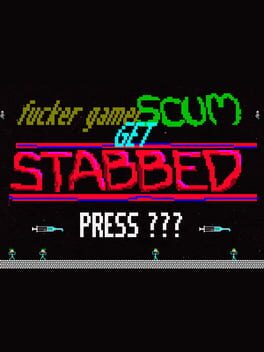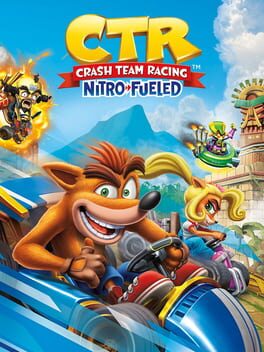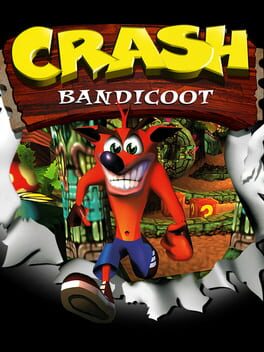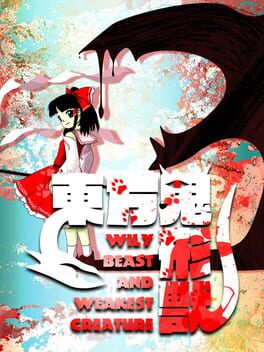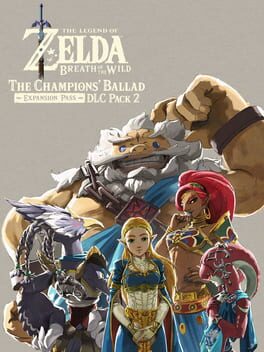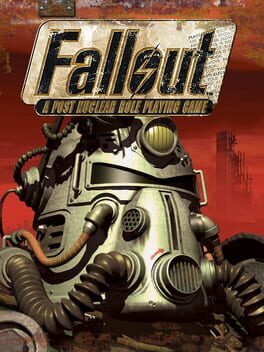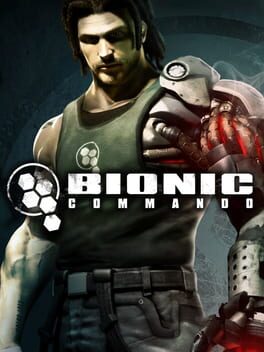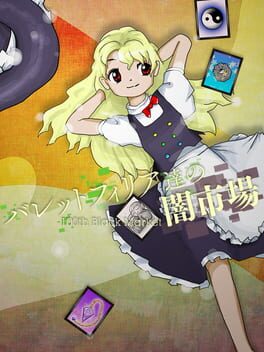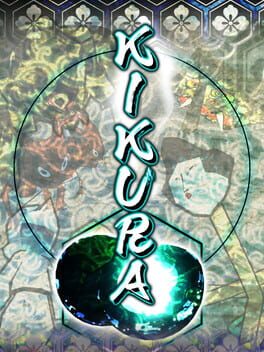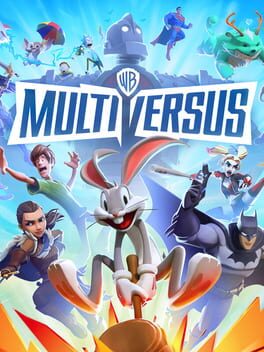Cakewalking
681 Reviews liked by Cakewalking
As eye-catching as this title may be, the game feels a bit like a poor new-age impression of John George Jones Games (Definitely recommend a read there, interesting insight into his works). "Go to Hell" felt like it had this petty hatred to the player that it kept through as you pushed through literal hell, while "Fucker Gamer Scum Get Stabbed" is explicitly made to feel juvenile and amateurish to the extend that I think this was intended to feel like it was made by a 14-year-old angsty boy. Which is fine, I guess.
Intraquartz
2022
if there’s a common element which threads together developer ilzard’s body of work thus far, it’s likely spatial navigation. both words prove relevant. nix umbra immensely complicates its sense of traversal primarily through disorientation and obfuscation. despite the relative frankness of its premise – time-based survival – its mechanics are cloaked enough to ensure that managing to wander undeterred in its shaded woods for even thirteen minutes will comfortably slot you in the top 50 of the title’s global leaderboards. the player’s only choice in nix umbra is to shrewdly maneuver impenetrable darkness, flailing wildly at the binaural screeching of violin strings indicating oncoming threats, and simultaneously attempting to process an occult set of mechanics which intentionally withholds its peculiarities. it’s hard not to reflect on the cosmos while playing, too. obviously traipsing around in pitch-black makes you vaguely feel like you’re navigating some sort of eschatological abyss unknown to man, but one mechanic the game declines to explicate involves using the stars above as a compass guiding you towards health & mana replenishing crystals in the woods. the game’s title translates roughly to “snow shadow” from latin – and as snowfall will occasionally dot the screen, it's difficult not to think of marine snow in the deepest zones of the ocean despite the game’s terrestrial concerns. as above, so below.
intraquartz represents a similar kind of disorienting spatial navigation. it is every bit as concerned with swirling depths as its predecessor is, albeit with a conceit which forces the player to adopt a mindset antithetical to survival in nix umbra. nix umbra’s swift and reactive gameplay recalls the pace of an arena shooter, where daring to stop is flirting with death, but while playing intraquartz it becomes clear that every action taken must be carefully weighed and considered, often for seconds at a time. this is because instead of obscuring your vision to a couple of meters ahead of you as in nix umbra, intraquartz renders every single path within the game’s various crystals completely invisible. nix umbra’s cold, apocalyptic void is substituted for the celestial gossamer of gems, each containing a microscopic, alien, and seemingly expansive inner galaxy. within each gemstone is a complex network of invisible tunnels which spiral endlessly, threatening to fold inwards on themselves. lateral movement is impossible because you take control of a rover, which forces the player to commit to wise decisions, and the player only has a select number of tools to aid them in mining the alien energy present in the crystals: distance-based coordinates, a refracting laser, a limited number of markers, and a limited number of quantum jumps.
so begins the process of orienting oneself and efficiently mapping out the twists and turns of each particular cavern. extracting even one energy core imposes a movement-based time limit on the rover as the crystal begins to destabilize, which incentivizes the player to have a rough outline of the crystal’s inner network before beginning the excavation process. energy cores which seem directly ahead of the player are likely blocked by some invisible wall or tunnel, forcing the intrepid rover to not simply bypass it, but to go under and over and around and then some – each detour is the full nine yards. markers allow for the player to either carefully breadcrumb their way around dizzying and dazzling labyrinths, or to lob shots and test the depths of the tunnels. refracting lasers can be used with surgical precision to reach tucked away energy cores as they perpetually ricochet off walls (a really commendable system given its smooth implementation), and quantum jumps aid in closing gaps that the rover would struggle with otherwise. each tool is perfectly considered and complementary in ways that reveal themselves to the player with each hour invested, and as such intraquartz becomes a game of mastery. the most coveted score for each level involves extracting each energy core without moving the rover, save for quantum jumps – an arduous task for a beginner, but a worthy challenge for the experienced. planning extensively to reach this offers satisfaction like nothing else can provide.
it's really admirable that the procedural generation utilized for the game’s energy cores ensures that this is not a game about strict puzzle solving, but rather a game about adaptive problem solving. there’s an argument to be made that once your brain is attuned to this game’s language it can sometimes feel a bit too much like second nature, but right up until that point it’s one of the most exhilarating games of 2022. at times soothing in its diligent pace, at times heartpounding when facing all-but-certain destabilization, and always an audiovisual tour de force about the worlds in grains of sand.
felt a pleasant sense of mirth when i saw the name of the final level. so excited for ilzard’s third outing!
intraquartz represents a similar kind of disorienting spatial navigation. it is every bit as concerned with swirling depths as its predecessor is, albeit with a conceit which forces the player to adopt a mindset antithetical to survival in nix umbra. nix umbra’s swift and reactive gameplay recalls the pace of an arena shooter, where daring to stop is flirting with death, but while playing intraquartz it becomes clear that every action taken must be carefully weighed and considered, often for seconds at a time. this is because instead of obscuring your vision to a couple of meters ahead of you as in nix umbra, intraquartz renders every single path within the game’s various crystals completely invisible. nix umbra’s cold, apocalyptic void is substituted for the celestial gossamer of gems, each containing a microscopic, alien, and seemingly expansive inner galaxy. within each gemstone is a complex network of invisible tunnels which spiral endlessly, threatening to fold inwards on themselves. lateral movement is impossible because you take control of a rover, which forces the player to commit to wise decisions, and the player only has a select number of tools to aid them in mining the alien energy present in the crystals: distance-based coordinates, a refracting laser, a limited number of markers, and a limited number of quantum jumps.
so begins the process of orienting oneself and efficiently mapping out the twists and turns of each particular cavern. extracting even one energy core imposes a movement-based time limit on the rover as the crystal begins to destabilize, which incentivizes the player to have a rough outline of the crystal’s inner network before beginning the excavation process. energy cores which seem directly ahead of the player are likely blocked by some invisible wall or tunnel, forcing the intrepid rover to not simply bypass it, but to go under and over and around and then some – each detour is the full nine yards. markers allow for the player to either carefully breadcrumb their way around dizzying and dazzling labyrinths, or to lob shots and test the depths of the tunnels. refracting lasers can be used with surgical precision to reach tucked away energy cores as they perpetually ricochet off walls (a really commendable system given its smooth implementation), and quantum jumps aid in closing gaps that the rover would struggle with otherwise. each tool is perfectly considered and complementary in ways that reveal themselves to the player with each hour invested, and as such intraquartz becomes a game of mastery. the most coveted score for each level involves extracting each energy core without moving the rover, save for quantum jumps – an arduous task for a beginner, but a worthy challenge for the experienced. planning extensively to reach this offers satisfaction like nothing else can provide.
it's really admirable that the procedural generation utilized for the game’s energy cores ensures that this is not a game about strict puzzle solving, but rather a game about adaptive problem solving. there’s an argument to be made that once your brain is attuned to this game’s language it can sometimes feel a bit too much like second nature, but right up until that point it’s one of the most exhilarating games of 2022. at times soothing in its diligent pace, at times heartpounding when facing all-but-certain destabilization, and always an audiovisual tour de force about the worlds in grains of sand.
felt a pleasant sense of mirth when i saw the name of the final level. so excited for ilzard’s third outing!
Crash Bandicoot
1996
Recommended by [maradona as part of this list! ]
As one of the key contributors to the brand identity of Sony’s gaming wheelhouse, Naughty Dog has centered itself as a pillar of prestige gaming, an ideologue pristinely focused on scavenging pop cultural landmarks on a relentless tear to put video games on a creative pedestal, sullying the individuality inherent to the medium in favor of some perceived notion of being considered “art”. Where we find the studio now, aping Indiana Jone’s blockbuster exploits in Uncharted and cutting surface-level highlight reels of post-apocalyptica in The Last of Us, exists primarily as a production house for wannabe-films in the name of cinematic gaming, but tracing back through the history of the developers work shows off a lost pedigree. Severed from the modern image of today, the Naughty Dog of the mid 90s was a beast cut from a different cloth, a proponent of the infamous Mascot Wars that defined the generation.
While the adage doesn't ring true today, the common knowledge of the 90s held that console exclusives and brand identity were the sword and shield brandished by the gaming industry. On the hallowed ground of internet forums, the nu-playground politics of the console war were waged equally in tech specs and pretty faces. By the time Sony entered the fray the battlefield was already established, with Sega and Nintendo locked in an eternal struggle for relevance. Competitors had risen, fallen, and been cast aside, but Sony remained as the last man standing against the twin behemoths. The dual-sided clash saw fit to tear the fate of the console market asunder, rendered desolate in the shockwave of mutually-assured destruction… Until he, the bearer of Sony’s curse, rose from primordial depths. Branded with the mark of enmity, the flag-bearer of PlayStation’s campaign cast a mocking shadow over the decade. Born into strife, with the serrated edge of the attitude era gripped tightly in his paw, Crash Bandicoot dug into his trench, grubby paws grasping for cultural leverage.
Mel Blanc-ian, a comic centerpiece made as much as a figurehead, Crash was the perfect scapegoat, an idol to cherish and ridicule in equal measure. A jester on the battleground of the modern technobandit, the mascot of yore breathed life into the indefinite scuffle that is brand identity. Becoming synonymous with genres and companies all their own, mascots, especially those in the realm of the mascot platformer, became analogous for not only the series and franchises they encompassed, but for the consoles they inhabited as well. Sega had Sonic, Nintendo had Mario, and Sony, fresh out the gate, had Crash Bandicoot, the mass-production beast forged by the wreckage of a thousand prototypes. The role, aside from poking fun at corporate rivals, was purely accessory, but as touchstones in the memories forged in the scorched earth of Gamefaqs forums, the mascot became an inescapable notion.
Years have since passed, and the Mascot Wars have drawn to the close. While some, the ever stalwart, cling to delusions of supremacy, the giants of the conflict settled into uneasy truces. With the three leaders co-mingling, interweaving, the tribalism of the past decades remains spoken in hushed whispers. Sega's great defeat in the Summer of 2001 saw the colossus fall, not by Nintendo's hand, or even by Microsoft's emerald super-soldier, but at the blade of Sony's masterwork, the PlayStation 2. With the fall of the esteemed leader, the war flickered, faded and died. However, for every victory, the heroes of the past are just as easily forgotten: with success coordinated in equal part by masters of tactical espionage and gods of war, the mascots that defined history were brushed away, hardened cynicism overtaking the endearing face of plucky spirit. Crash, Sly, Croc, even the maligned Gex, all shunned by the tides of time.
The era defined by the mascot has long since passed. Yes, false idols clammer to the throne, halls besieged by Hat Kids and Yooka-Laylees, but the original generation has faded, gussied up only to be showboated in recollections and remasterings. The soul, flickering against the growing cynicism of the game industry, now rests as post-ironic detached nostalgia.
…none of this has anything to do with the actual game of Crash Bandicoot, and that’s because there’s very little to say about Crash Bandicoot. Like any property in the 90s that uses the aesthetics of tribal villages, shockingly racist! Literally my only comment on the content of the game itself. ¯\(ツ)/¯
As one of the key contributors to the brand identity of Sony’s gaming wheelhouse, Naughty Dog has centered itself as a pillar of prestige gaming, an ideologue pristinely focused on scavenging pop cultural landmarks on a relentless tear to put video games on a creative pedestal, sullying the individuality inherent to the medium in favor of some perceived notion of being considered “art”. Where we find the studio now, aping Indiana Jone’s blockbuster exploits in Uncharted and cutting surface-level highlight reels of post-apocalyptica in The Last of Us, exists primarily as a production house for wannabe-films in the name of cinematic gaming, but tracing back through the history of the developers work shows off a lost pedigree. Severed from the modern image of today, the Naughty Dog of the mid 90s was a beast cut from a different cloth, a proponent of the infamous Mascot Wars that defined the generation.
While the adage doesn't ring true today, the common knowledge of the 90s held that console exclusives and brand identity were the sword and shield brandished by the gaming industry. On the hallowed ground of internet forums, the nu-playground politics of the console war were waged equally in tech specs and pretty faces. By the time Sony entered the fray the battlefield was already established, with Sega and Nintendo locked in an eternal struggle for relevance. Competitors had risen, fallen, and been cast aside, but Sony remained as the last man standing against the twin behemoths. The dual-sided clash saw fit to tear the fate of the console market asunder, rendered desolate in the shockwave of mutually-assured destruction… Until he, the bearer of Sony’s curse, rose from primordial depths. Branded with the mark of enmity, the flag-bearer of PlayStation’s campaign cast a mocking shadow over the decade. Born into strife, with the serrated edge of the attitude era gripped tightly in his paw, Crash Bandicoot dug into his trench, grubby paws grasping for cultural leverage.
Mel Blanc-ian, a comic centerpiece made as much as a figurehead, Crash was the perfect scapegoat, an idol to cherish and ridicule in equal measure. A jester on the battleground of the modern technobandit, the mascot of yore breathed life into the indefinite scuffle that is brand identity. Becoming synonymous with genres and companies all their own, mascots, especially those in the realm of the mascot platformer, became analogous for not only the series and franchises they encompassed, but for the consoles they inhabited as well. Sega had Sonic, Nintendo had Mario, and Sony, fresh out the gate, had Crash Bandicoot, the mass-production beast forged by the wreckage of a thousand prototypes. The role, aside from poking fun at corporate rivals, was purely accessory, but as touchstones in the memories forged in the scorched earth of Gamefaqs forums, the mascot became an inescapable notion.
Years have since passed, and the Mascot Wars have drawn to the close. While some, the ever stalwart, cling to delusions of supremacy, the giants of the conflict settled into uneasy truces. With the three leaders co-mingling, interweaving, the tribalism of the past decades remains spoken in hushed whispers. Sega's great defeat in the Summer of 2001 saw the colossus fall, not by Nintendo's hand, or even by Microsoft's emerald super-soldier, but at the blade of Sony's masterwork, the PlayStation 2. With the fall of the esteemed leader, the war flickered, faded and died. However, for every victory, the heroes of the past are just as easily forgotten: with success coordinated in equal part by masters of tactical espionage and gods of war, the mascots that defined history were brushed away, hardened cynicism overtaking the endearing face of plucky spirit. Crash, Sly, Croc, even the maligned Gex, all shunned by the tides of time.
The era defined by the mascot has long since passed. Yes, false idols clammer to the throne, halls besieged by Hat Kids and Yooka-Laylees, but the original generation has faded, gussied up only to be showboated in recollections and remasterings. The soul, flickering against the growing cynicism of the game industry, now rests as post-ironic detached nostalgia.
…none of this has anything to do with the actual game of Crash Bandicoot, and that’s because there’s very little to say about Crash Bandicoot. Like any property in the 90s that uses the aesthetics of tribal villages, shockingly racist! Literally my only comment on the content of the game itself. ¯\(ツ)/¯
Air Twister
2022
plays like a bizarro space harrier/panzer dragoon riff. might unironically be one of the best games this year. princess arch needs to be in the pantheon of gaming legends pronto. only yu suzuki can make this many bolted together assets have this much swag. thats why he's the crown prince of gaming and the rest of you are making two hour long video essays about how shenmue 3 didnt cure your anhedonia
Fallout
1997
The trouble with calling something “ahead of its time” is that it implies whatever made that something so special has become standard since its release. It’s easy to describe Fallout like that, or to say it’s “impressive for 1997” as if standards only ever improve over time, until you look around and realise how few RPGs since Fallout have even attempted to replicate what makes it such an excellent game, including its own sequels. Had they, it’s doubtful that Fallout would be subject to as many hyperbolic horror stories as it is today.
Among the most infamous and exaggerated of these is the time limit of Fallout’s main quest, which isn’t just arguably more generous than it should be even if you don’t choose to extend it, but also disappears halfway through anyhow. That makes it sound like a non-factor, but it’s an essential part of what makes Fallout a step above. No matter how generous it might be, the fact that it’s there at all creates a kind of congruence between player and protagonist that isn’t there in any other Fallout game, or many RPGs in general. Everything you do in Fallout is coloured by the underlying sense of urgency that it’s game over, literally and figuratively, if you spend too much time gallivanting about the wastes instead of on your core responsibility. The plights of Arroyo, Liam Neeson and Hoover Dam can wait until the Chosen One, Lone Wanderer and Courier feel like doing something about it, but unlike them, the world doesn’t revolve around the Vault Dweller. It probably doesn’t need to be said how much more synergistic this is with Fallout’s harsh setting than any its follow-ups, or how relieving it is when you finally get your hands on that water chip.
What this is indicative of is Fallout’s larger design philosophy – it isn’t afraid to let you make mistakes. Yes, you’re going to have a particularly hard time if you don’t dump points into your Agility, but why shouldn’t you? It makes sense that someone who isn’t quick on their feet shouldn’t be able to easily get by in such a hellish place. You feel the consequences of neglecting a particular S.P.E.C.I.A.L. stat more palpably here than in any other Fallout bar 2, most famously with how low Intelligence makes every single conversation in the game more strained (to say the least).
This design extends beyond character building, too. Fallout trusts players to figure out for themselves which dialogue options are affected by a high speech skill, instead of highlighting them for you as all of the 3D games do. Choose your words poorly upon meeting someone for the first time and their opinion of you can be permanently dampened for the rest of the game, signalled to you organically with a change in their facial expression, potentially locking you out of quests or causing others in the locale to distrust you. If things go really south, no punches are pulled in terms of everybody being expendable – you can go as far as to kill children, and making a good first impression with even evil characters becomes an uphill battle if you do.
In general, I don’t think killing things in Fallout is anywhere near as much of a drag as it’s often made out to be either. Weighing up how much AP to spend on either moving to get to a more advantageous position and reduce the amount of actions enemies can potentially take, or on attacking them definitely gets the gears in your head turning to some extent. Damage sound effects in this series never sounded anywhere near as satisfying after ditching the thumps and thwacks of this and Fallout 2, which make for some nice feedback on attacks when taken in tandem with the wonderfully gory sprite work. Being able to destroy or pry open doors enables ways for you to creatively manoeuvre through combat encounters and lets you progress quests in ways that you can’t in later titles, plus the amount of different hit reactions for each part of each enemy’s body is also pretty novel. You won’t be making any Combo MADs out of this, but if you don’t get even a hint of enjoyment out of seeing somebody gently slide across half of Los Angeles after they’ve been smacked with a sledgehammer, I probably don’t trust you.
What I do trust is Fallout’s ability to engross me in its world every single time I play it. Listen to how haunting this is, and then be aware that every other track in the game is at least on par with it. The ambient clicking and clacking of now ancient wartime equipment, the cosy boxed-in presentation of the HUD and its descriptive flavour text in its bottom left, the freaky architecture with all its giant heads... they all combine to sell the feeling of really being there, rivalling the best of any other game that predicates itself on immersion. When you encounter a voiced character and the music cuts you know you’re in for a proper event, bolstered by across the board stellar performances from tons of classic 90s voice actors that utterly command your attention. Meeting the Master and hearing him jolt his way through his iconic monologue about the Unity is like one long lesson in why he ended up defining the guy-with-good-intentions-does-the-wrong-thing-for-the-right-reasons-and-also-you-can-talk-him-to-death archetype. No Fallout antagonist has come close ever since (as cool as Frank Horrigan might be), be it in terms of motivations, the lengths you have to go to convince him that he’s in the wrong, anything.
Fallout is a remarkably pure translation of vision to game, and as another comment on here points out, it’s simply not given its dues as often as it ought to be. Even with this proverbial Vault of text, I still haven’t touched on everything it does well – for one thing, I can’t believe the Tell Me About feature didn’t become standard in every RPG made after this game’s release – but I hope this does it some justice all the same. Do give it a chance at some point if you haven’t already, and don’t be put off by any claims of “jank” or “clunk” or whatever other nebulous jargon you could just as easily apply to any of its much more recent successors. I first played Fallout well over a decade after it came out after being introduced to the series with 3, and even as a kid, I never found myself wishing it was more like the modern RPGs I was accustomed to. Quite the opposite.
I wanted to cap this off with a twist on “you’re a hero and you have to leave,” Fallout being the hero, but my Int is too low to make it sound clever. In the interest of avoiding a critical miss, I present a rare but thematically appropriate Todd. Will trade for either 20 caps or an iguana on a stick.
Among the most infamous and exaggerated of these is the time limit of Fallout’s main quest, which isn’t just arguably more generous than it should be even if you don’t choose to extend it, but also disappears halfway through anyhow. That makes it sound like a non-factor, but it’s an essential part of what makes Fallout a step above. No matter how generous it might be, the fact that it’s there at all creates a kind of congruence between player and protagonist that isn’t there in any other Fallout game, or many RPGs in general. Everything you do in Fallout is coloured by the underlying sense of urgency that it’s game over, literally and figuratively, if you spend too much time gallivanting about the wastes instead of on your core responsibility. The plights of Arroyo, Liam Neeson and Hoover Dam can wait until the Chosen One, Lone Wanderer and Courier feel like doing something about it, but unlike them, the world doesn’t revolve around the Vault Dweller. It probably doesn’t need to be said how much more synergistic this is with Fallout’s harsh setting than any its follow-ups, or how relieving it is when you finally get your hands on that water chip.
What this is indicative of is Fallout’s larger design philosophy – it isn’t afraid to let you make mistakes. Yes, you’re going to have a particularly hard time if you don’t dump points into your Agility, but why shouldn’t you? It makes sense that someone who isn’t quick on their feet shouldn’t be able to easily get by in such a hellish place. You feel the consequences of neglecting a particular S.P.E.C.I.A.L. stat more palpably here than in any other Fallout bar 2, most famously with how low Intelligence makes every single conversation in the game more strained (to say the least).
This design extends beyond character building, too. Fallout trusts players to figure out for themselves which dialogue options are affected by a high speech skill, instead of highlighting them for you as all of the 3D games do. Choose your words poorly upon meeting someone for the first time and their opinion of you can be permanently dampened for the rest of the game, signalled to you organically with a change in their facial expression, potentially locking you out of quests or causing others in the locale to distrust you. If things go really south, no punches are pulled in terms of everybody being expendable – you can go as far as to kill children, and making a good first impression with even evil characters becomes an uphill battle if you do.
In general, I don’t think killing things in Fallout is anywhere near as much of a drag as it’s often made out to be either. Weighing up how much AP to spend on either moving to get to a more advantageous position and reduce the amount of actions enemies can potentially take, or on attacking them definitely gets the gears in your head turning to some extent. Damage sound effects in this series never sounded anywhere near as satisfying after ditching the thumps and thwacks of this and Fallout 2, which make for some nice feedback on attacks when taken in tandem with the wonderfully gory sprite work. Being able to destroy or pry open doors enables ways for you to creatively manoeuvre through combat encounters and lets you progress quests in ways that you can’t in later titles, plus the amount of different hit reactions for each part of each enemy’s body is also pretty novel. You won’t be making any Combo MADs out of this, but if you don’t get even a hint of enjoyment out of seeing somebody gently slide across half of Los Angeles after they’ve been smacked with a sledgehammer, I probably don’t trust you.
What I do trust is Fallout’s ability to engross me in its world every single time I play it. Listen to how haunting this is, and then be aware that every other track in the game is at least on par with it. The ambient clicking and clacking of now ancient wartime equipment, the cosy boxed-in presentation of the HUD and its descriptive flavour text in its bottom left, the freaky architecture with all its giant heads... they all combine to sell the feeling of really being there, rivalling the best of any other game that predicates itself on immersion. When you encounter a voiced character and the music cuts you know you’re in for a proper event, bolstered by across the board stellar performances from tons of classic 90s voice actors that utterly command your attention. Meeting the Master and hearing him jolt his way through his iconic monologue about the Unity is like one long lesson in why he ended up defining the guy-with-good-intentions-does-the-wrong-thing-for-the-right-reasons-and-also-you-can-talk-him-to-death archetype. No Fallout antagonist has come close ever since (as cool as Frank Horrigan might be), be it in terms of motivations, the lengths you have to go to convince him that he’s in the wrong, anything.
Fallout is a remarkably pure translation of vision to game, and as another comment on here points out, it’s simply not given its dues as often as it ought to be. Even with this proverbial Vault of text, I still haven’t touched on everything it does well – for one thing, I can’t believe the Tell Me About feature didn’t become standard in every RPG made after this game’s release – but I hope this does it some justice all the same. Do give it a chance at some point if you haven’t already, and don’t be put off by any claims of “jank” or “clunk” or whatever other nebulous jargon you could just as easily apply to any of its much more recent successors. I first played Fallout well over a decade after it came out after being introduced to the series with 3, and even as a kid, I never found myself wishing it was more like the modern RPGs I was accustomed to. Quite the opposite.
I wanted to cap this off with a twist on “you’re a hero and you have to leave,” Fallout being the hero, but my Int is too low to make it sound clever. In the interest of avoiding a critical miss, I present a rare but thematically appropriate Todd. Will trade for either 20 caps or an iguana on a stick.
Mass Effect 3
2012
The gamer intelligentsia have led me astray. Mass Effect 3’s ending is relatively alright (heavy emphasis on “relatively”) – it’s near enough everything else that’s the problem.
Enough time and post-release patches have passed now that its stronger aspects have started to overshadow its shortcomings, which to an extent isn’t without merit. Intergalactic supersoldier Shepard no longer struggles to breathe after jogging for three seconds and has learned how to dodge roll, making movement less restrictive in general. The game makes full use of his enhanced agility through a legitimately great enemy roster which sports all sorts of new dynamic behaviours, whether it be homing projectiles or lunging attacks or setting up turrets to create chokepoints on the fly. Feedback on attacks is probably the most cathartic it’s ever been, in no small part thanks to power combos, which also go some way toward making the RPG mechanics feel the most relevant they’ve been since the original.
You might notice that that’s all to do with combat, which is because it’s about the only respect in which ME3 isn’t an unequivocal step back from its predecessors. The already simplistic dialogue wheel’s stripped down even further, the player barely having any control over what Shepard says most of the time and the middle option often being axed in the few instances where you do. This kind of railroading wouldn’t be so egregious if Paragon and Renegade choices weren’t as polarised as they are; alternating between the two within the same conversation feels akin to a series of mood swings, with Shepard going from Aslan one moment to Judge Holden the next, now with no in-between. No part of the game better illustrates how poor a roleplaying avatar Shepard has become than the fact that you can choose to murder a longtime friend, doom his billions-strong race to extinction and proceed to lie about it in the most aloof tone possible, only to then have to sit through PTSD-induced nightmares over the implied off-screen death of some kid he’d only seen for the first time a few minutes prior.
The impressively lame Kai Leng and the inability to shove him into a locker would be enough to dock several points on its own, but many of the other side characters aren’t inspiringly handled either. I laughed when a certain somebody died in the main quest’s finale, not because I particularly disliked him, but because of the contrast between Shepard’s mournful head shake and my trying to remember what his name was. Tali’s Joss Whedon-isms feel similarly misplaced aboard a ship controlled and staffed by hostile AI in the midst of a battle for the fate of her species. Ashley and Liara continue to suffer from essentially becoming different characters in each game of the trilogy, though Javik is a saving grace and his deconstruction of the latter’s naive preconceptions about his people is about the only personality she’s afforded. James also exists, supposedly, though you could be forgiven for thinking otherwise given that you can’t actually speak to him or anyone else anymore once you’ve exhausted all the dialogue they’re generously granted for whichever point in the main quest you’re at.
I praised the combat earlier, but no amount of bolted on, marginal improvements can offset how woefully uninteresting the scenarios you fight through are. Prior to the release of Dragon Age II, someone at Bioware was infamously misquoted as saying they “want the Call of Duty audience,” but what's on offer here doesn't feel far removed from this hypothetical philosophy. Much more often than in either of the prior games, control’s wrestled away from you for such invigorating setpieces as sliding down a small pile of rubble, the stakes these are obviously trying to communicate rendered inert by how it’s impossible for you to be in danger during them. Just about every situation, from making your way down to the hideaway of ancient sub-aquatic alien giants to aiming missile batteries at the weak point of a starship, is solved through wave-based survival sequences in square arenas that wear out their welcome within the first hour. The return to Omega is the epitome of this sort of design, and a microcosm of ME3 in general, because for all intents and purposes it’s not actually Omega – it’s a series of linear shooting galleries that happens to look like Omega, with all the merchants, quest givers, decision-making and everything else resembling an RPG snuffed out.
It’s staggering how dreary the first few parts of this game manage to be considering it opens with a full scale invasion of Earth, but I caution against wanting it to be over with as soon as possible like I did. As a result, I skipped a certain sidequest, not initially knowing that they’re effectively just excuses to catch up the cast of ME2, and it led to one character making a reappearance as a standard, unaltered enemy who happens to share her name and reuse that one voice clip from ME1. It’s so shoddy I like to imagine it’s intentionally so, to really drive home what a punishment for lazy players it is, but even this rationalisation can’t shake the feeling that I would’ve preferred nothing at all.
I’ve written before about how I prefer to avoid negativity unless I can use it to highlight something else I care for, and I hold to that – cynically tearing down somebody else’s hard work is as effortless as it is exhausting, both to do and to read. But nothing’s made me appreciate what lightning in a bottle ME1 was quite like experiencing firsthand how hard its potential was fumbled. From the HUD, to the composition of your squad, to the ending’s attempt to bring back ME1’s focus on organic vs. synthetic life (for which I give it credit), ME3 is drenched in the feeling that it really wants to be ME1 again. I wish it wasn’t, because I’d rather just replay that instead, even knowing where it leads to.
I should go.
Enough time and post-release patches have passed now that its stronger aspects have started to overshadow its shortcomings, which to an extent isn’t without merit. Intergalactic supersoldier Shepard no longer struggles to breathe after jogging for three seconds and has learned how to dodge roll, making movement less restrictive in general. The game makes full use of his enhanced agility through a legitimately great enemy roster which sports all sorts of new dynamic behaviours, whether it be homing projectiles or lunging attacks or setting up turrets to create chokepoints on the fly. Feedback on attacks is probably the most cathartic it’s ever been, in no small part thanks to power combos, which also go some way toward making the RPG mechanics feel the most relevant they’ve been since the original.
You might notice that that’s all to do with combat, which is because it’s about the only respect in which ME3 isn’t an unequivocal step back from its predecessors. The already simplistic dialogue wheel’s stripped down even further, the player barely having any control over what Shepard says most of the time and the middle option often being axed in the few instances where you do. This kind of railroading wouldn’t be so egregious if Paragon and Renegade choices weren’t as polarised as they are; alternating between the two within the same conversation feels akin to a series of mood swings, with Shepard going from Aslan one moment to Judge Holden the next, now with no in-between. No part of the game better illustrates how poor a roleplaying avatar Shepard has become than the fact that you can choose to murder a longtime friend, doom his billions-strong race to extinction and proceed to lie about it in the most aloof tone possible, only to then have to sit through PTSD-induced nightmares over the implied off-screen death of some kid he’d only seen for the first time a few minutes prior.
The impressively lame Kai Leng and the inability to shove him into a locker would be enough to dock several points on its own, but many of the other side characters aren’t inspiringly handled either. I laughed when a certain somebody died in the main quest’s finale, not because I particularly disliked him, but because of the contrast between Shepard’s mournful head shake and my trying to remember what his name was. Tali’s Joss Whedon-isms feel similarly misplaced aboard a ship controlled and staffed by hostile AI in the midst of a battle for the fate of her species. Ashley and Liara continue to suffer from essentially becoming different characters in each game of the trilogy, though Javik is a saving grace and his deconstruction of the latter’s naive preconceptions about his people is about the only personality she’s afforded. James also exists, supposedly, though you could be forgiven for thinking otherwise given that you can’t actually speak to him or anyone else anymore once you’ve exhausted all the dialogue they’re generously granted for whichever point in the main quest you’re at.
I praised the combat earlier, but no amount of bolted on, marginal improvements can offset how woefully uninteresting the scenarios you fight through are. Prior to the release of Dragon Age II, someone at Bioware was infamously misquoted as saying they “want the Call of Duty audience,” but what's on offer here doesn't feel far removed from this hypothetical philosophy. Much more often than in either of the prior games, control’s wrestled away from you for such invigorating setpieces as sliding down a small pile of rubble, the stakes these are obviously trying to communicate rendered inert by how it’s impossible for you to be in danger during them. Just about every situation, from making your way down to the hideaway of ancient sub-aquatic alien giants to aiming missile batteries at the weak point of a starship, is solved through wave-based survival sequences in square arenas that wear out their welcome within the first hour. The return to Omega is the epitome of this sort of design, and a microcosm of ME3 in general, because for all intents and purposes it’s not actually Omega – it’s a series of linear shooting galleries that happens to look like Omega, with all the merchants, quest givers, decision-making and everything else resembling an RPG snuffed out.
It’s staggering how dreary the first few parts of this game manage to be considering it opens with a full scale invasion of Earth, but I caution against wanting it to be over with as soon as possible like I did. As a result, I skipped a certain sidequest, not initially knowing that they’re effectively just excuses to catch up the cast of ME2, and it led to one character making a reappearance as a standard, unaltered enemy who happens to share her name and reuse that one voice clip from ME1. It’s so shoddy I like to imagine it’s intentionally so, to really drive home what a punishment for lazy players it is, but even this rationalisation can’t shake the feeling that I would’ve preferred nothing at all.
I’ve written before about how I prefer to avoid negativity unless I can use it to highlight something else I care for, and I hold to that – cynically tearing down somebody else’s hard work is as effortless as it is exhausting, both to do and to read. But nothing’s made me appreciate what lightning in a bottle ME1 was quite like experiencing firsthand how hard its potential was fumbled. From the HUD, to the composition of your squad, to the ending’s attempt to bring back ME1’s focus on organic vs. synthetic life (for which I give it credit), ME3 is drenched in the feeling that it really wants to be ME1 again. I wish it wasn’t, because I’d rather just replay that instead, even knowing where it leads to.
I should go.
Mass Effect 2
2010
Doesn't make a whole lot of sense actually? Now that I'm coming with the correct context of ME1, ME2 does a lot of weird shit. Like, why am I automatically working with Cerberus, an actual terrorist organization that has done actual crimes? It's such a bizarre decision to strongarm Shephard into working with them despite how pro-cooperative and pro-alien you can be in ME1. And why would Joker work with them as well? I didn't talk to Joker much in ME1 but working with actual terrorists is such a jump for him even if the Alliance is doing their bureaucratic bullshit. Like, Cerebrus isn't just some rebel/outlaw faction that Sidesteps Democratic Insufficiency, they've literally attempted a hijacking of a Quarian ship and bombed it. I get the game is going full hard-on with this jingoist fantasy of Special Operatives Who Always Get The Job Done, but this is so far gone. It'd be like if you had a game about an American War Hero in the Iraq War, and then in the sequel you found out the War Hero is resurrected and being supplied by ISIS. Except Cerberus has far-less justification than Middle Eastern terrorism. Just a bizarre narrative decision.
I'll accept the sideswiping of working with Cerebrus--the game tries its hardest to assuage Paragon players that they're just working with Cerebrus, not actually under Cerebrus; a pretty meaningless distinction but fine, maybe there's a larger narrative point the writers want to hit and having Paragons work with Cerebrus was the best way to do that. What I don't get as readily is the wild swings in everything else that happens in the game. You have Mordin over here who's pretty unshaken by having participated in the Krogan Genophage Project, so there's that can of worms again; then over here you have Miranda who's just a pandora box of genetic modification, perfectionism, and inadequacy schemas, so there's that character arc; then you have Jack who also has her share of inadequacy schemas and as well as lot of weird codification by the writers to have her be this 'abused' or 'damaged goods' bad girl archetype; Jacob is the 'sane one', which is okay, but it feels kinda weird that they gave the black character a lack of interiority but whatever. And then you have the batshit DLC characters Zaeed and Kasumi with their own short but strangely excessive plotlines as well. Now having all this in your game is fine, my question is: what's the point?
The personal traumas at play with the characters here are fine, and they should be explored, but what's the connection between any of them? In ME1 all the lore about the Krogan Genophage, the Reapers, the Protheans, the Alliance, the Council, the romance options, squad decisions, etc. all lead to the central question of the game: how should human civilization interact with aliens? Whether we should integrate on our hands and knees, be cordial but maintain our own interest, or assert dominance is all up to the player's Shephard. And the game tries to provide evidence for and against all three different paths using both the history of the world and what happens on your quest to defeat Saren. Even small design decisions like having to buy non-Human armor for your squad can help players express how willing or unwilling they are towards accommodating aliens. Now, you can think the way Mass Effect 1 goes about these connections makes the game overall more tedious to play, or that the way the actual event-by-event plot moves is not entertaining, but there's a far more cohesive narrative in that game than in this one. There's a cohesive sense of edginess and grittiness in ME2, reinforced by the moral ambiguities, Cerberus, the 'suicide mission', setting a lot of the conflict outside the Council's jurisdiction, the more urban and oppressive combat settings versus the open plains and industrial rooms of ME1, etc. It's a coherent and understandable tonal shift, but what is this tonal shift saying? And that's probably my biggest problem with ME2--it's in many ways less tedious than ME1, but it's not saying anything compelling, which makes it a good bit more boring to me than its already rather sterile predecessor.
I'll accept the sideswiping of working with Cerebrus--the game tries its hardest to assuage Paragon players that they're just working with Cerebrus, not actually under Cerebrus; a pretty meaningless distinction but fine, maybe there's a larger narrative point the writers want to hit and having Paragons work with Cerebrus was the best way to do that. What I don't get as readily is the wild swings in everything else that happens in the game. You have Mordin over here who's pretty unshaken by having participated in the Krogan Genophage Project, so there's that can of worms again; then over here you have Miranda who's just a pandora box of genetic modification, perfectionism, and inadequacy schemas, so there's that character arc; then you have Jack who also has her share of inadequacy schemas and as well as lot of weird codification by the writers to have her be this 'abused' or 'damaged goods' bad girl archetype; Jacob is the 'sane one', which is okay, but it feels kinda weird that they gave the black character a lack of interiority but whatever. And then you have the batshit DLC characters Zaeed and Kasumi with their own short but strangely excessive plotlines as well. Now having all this in your game is fine, my question is: what's the point?
The personal traumas at play with the characters here are fine, and they should be explored, but what's the connection between any of them? In ME1 all the lore about the Krogan Genophage, the Reapers, the Protheans, the Alliance, the Council, the romance options, squad decisions, etc. all lead to the central question of the game: how should human civilization interact with aliens? Whether we should integrate on our hands and knees, be cordial but maintain our own interest, or assert dominance is all up to the player's Shephard. And the game tries to provide evidence for and against all three different paths using both the history of the world and what happens on your quest to defeat Saren. Even small design decisions like having to buy non-Human armor for your squad can help players express how willing or unwilling they are towards accommodating aliens. Now, you can think the way Mass Effect 1 goes about these connections makes the game overall more tedious to play, or that the way the actual event-by-event plot moves is not entertaining, but there's a far more cohesive narrative in that game than in this one. There's a cohesive sense of edginess and grittiness in ME2, reinforced by the moral ambiguities, Cerberus, the 'suicide mission', setting a lot of the conflict outside the Council's jurisdiction, the more urban and oppressive combat settings versus the open plains and industrial rooms of ME1, etc. It's a coherent and understandable tonal shift, but what is this tonal shift saying? And that's probably my biggest problem with ME2--it's in many ways less tedious than ME1, but it's not saying anything compelling, which makes it a good bit more boring to me than its already rather sterile predecessor.
Bionic Commando
2009
Kikura
TBD
Mum: We have Guwange at home
Guwange at home:
Comiket 100's non-Touhou STG of real note, Kikura's big issue is that it should have been C101's. Even by the standards of doujin shooters where having arcane boot menus that need your system language changing to work, Kikura is rough. It works my PC harder than Guilty Gear strive, it's 5gb for some reason, has barely functional menus and gameplay balance that is all over the place, as well just a bunch of design elements that feel outright unfinished.
Kikura is probably best described as the intersection of Pocky and Rocky with Touhou, but the influence from Guwange is so obvious and the game is at it's best when it's cribbing Cave's notes. The grounded shooting, whilst dealing with the constantly shifting scrolling directions and enemy formations coming from loads of angles is great stuff, and also something that has gone underexplored by basically anyone in a bullet hell since 1999. And the pretty ridiculous bullet count of Kikura makes that especially interersting and engaging, and with it's very low pricetag of £3 - it's worth checking out just for that.
But it could be so much better. The playfield being bafflingly defined by red wireframe boxes is probably the first thing that'll stick out to people. It's just fucking weird, i don't know how else to put it, its as if the stage graphics were just incomplete and they scrambled to make the stage border better defined, I legitimately couldn't come up with a reasonable explanation for doing such a thing.
Sound design is also bad. Don't get me wrong, the music is good, no complaints there, but enemies are weirdly quiet doing almost anything, which gives this real element of having to double take and visually verify for enemy deaths in a game where due to the changing playfield. This may be being too charitable, but i don't think it's bad, I just think it's legitimately unfinished. Graphics are in a similar state, with the type B shottype having some effects which look very "placeholder".
I don't get it. Kikura has the bones of a good succsessor to Guwange, and the devs here clearly have the talent to put the bits together, but it just doesnt feel done. Not in the "damn the giant's archstone got canned :(" sort of way but in that it feels like a proof of concept version that has somehow made it to wide release.
It's £3 so I can't complain too much, but i'd still encourage caution on trying it out, as it does seem the devs are continuing to fix things, and there's enough evidence in the stuff that works that this game could become good, maybe great. But fuck me, releasing in this state might be it's deathnell. It is a rare STG who's reputation survives an "early access" release like this... if thats even what it is.
Guwange at home:
Comiket 100's non-Touhou STG of real note, Kikura's big issue is that it should have been C101's. Even by the standards of doujin shooters where having arcane boot menus that need your system language changing to work, Kikura is rough. It works my PC harder than Guilty Gear strive, it's 5gb for some reason, has barely functional menus and gameplay balance that is all over the place, as well just a bunch of design elements that feel outright unfinished.
Kikura is probably best described as the intersection of Pocky and Rocky with Touhou, but the influence from Guwange is so obvious and the game is at it's best when it's cribbing Cave's notes. The grounded shooting, whilst dealing with the constantly shifting scrolling directions and enemy formations coming from loads of angles is great stuff, and also something that has gone underexplored by basically anyone in a bullet hell since 1999. And the pretty ridiculous bullet count of Kikura makes that especially interersting and engaging, and with it's very low pricetag of £3 - it's worth checking out just for that.
But it could be so much better. The playfield being bafflingly defined by red wireframe boxes is probably the first thing that'll stick out to people. It's just fucking weird, i don't know how else to put it, its as if the stage graphics were just incomplete and they scrambled to make the stage border better defined, I legitimately couldn't come up with a reasonable explanation for doing such a thing.
Sound design is also bad. Don't get me wrong, the music is good, no complaints there, but enemies are weirdly quiet doing almost anything, which gives this real element of having to double take and visually verify for enemy deaths in a game where due to the changing playfield. This may be being too charitable, but i don't think it's bad, I just think it's legitimately unfinished. Graphics are in a similar state, with the type B shottype having some effects which look very "placeholder".
I don't get it. Kikura has the bones of a good succsessor to Guwange, and the devs here clearly have the talent to put the bits together, but it just doesnt feel done. Not in the "damn the giant's archstone got canned :(" sort of way but in that it feels like a proof of concept version that has somehow made it to wide release.
It's £3 so I can't complain too much, but i'd still encourage caution on trying it out, as it does seem the devs are continuing to fix things, and there's enough evidence in the stuff that works that this game could become good, maybe great. But fuck me, releasing in this state might be it's deathnell. It is a rare STG who's reputation survives an "early access" release like this... if thats even what it is.
